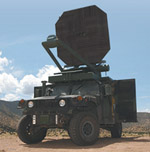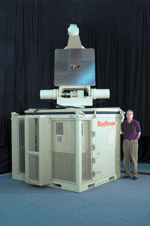Heat Ray Warms Up for Operation
 |
| The Active Denial System (ADS) uses a focused beam of directed energy to peacefully disperse crowds that could threaten U.S. forces. The system uses millimeter waves to heat the outermost layers of a person’s skin, causing a burning reaction. Targeted individuals automatically jump out of the beam’s path. The ADS technology provides U.S. forces with a viable option to lethal force in crowd control and riot situations. |
In both peacekeeping and combat situations,
The Active Denial System (ADS) uses radio frequency radiation to cause the nerves in the outer layers of a target’s skin to feel sudden, burning heat. Targeted individuals immediately and uncontrollably jump away from the beam. Mounted on the back of a vehicle such as a high-mobility multipurpose wheeled vehicle (HMMWV) or a truck, the ADS is effective at ranges in excess of 500 meters (1,650 feet). This distance allows forces the time and safety to assess a situation, disperse a crowd and identify any insurgents.
Managed by the Joint Non-Lethal Weapons Program (JNLWP), part of the Joint Non-Lethal Weapons Directorate,
According to Susan LeVine, principal deputy director for policy and strategy at the JNLWP, the ADS began as a concept demonstration program. An ADS technology demonstrator was successfully tested in 2001. In 2002, the Defense Department designated the ADS as an advanced concept technology demonstration (ACTD) program to rapidly mature and move the technology to warfighters. Under the ACTD, the ADS System 1 was installed in a HMMWV.
A more ruggedized version designed to withstand the dust of
The key part of the ADS is an antenna that produces 95-gigahertz millimeter waves that penetrate the outer layers of a target’s skin, up to a depth of 1/64th of an inch. The waves cause a heating sensation that becomes intolerable within seconds, forcing targets to move out of the beam’s path instinctively. According the JNLWP, the sensation immediately stops when an individual leaves the beam. The Defense Department also notes that the beam does not cause injury because of its shallow penetration depth and the safety features designed into the system. The system’s hardware allows the operator to view the entire beam path and target area while the millimeter waves require no adjustments for ballistics or wind. The ADS also features computer safety systems to limit shot duration to several seconds. Other safety measures include engagement procedures, software upgrades, checklists and a multiperson validated compliance and enhanced training process.
LeVine adds that extensive research has been conducted to determine the weapon’s effects on the human body. The AFRL Human Effectiveness Directorate at Brooks City-Base,
 |
 |
| The Raytheon Company, which developed the ADS technology, has produced its own version of the system. Silent Guardian is smaller and lighter than the JNLWP version. The smaller signature allows the system to be mounted on civilian vehicles for use by law enforcement agencies. |
The program is continuing to work on developing the ADS technology to make it lighter and smaller. LeVine says that one goal of the miniaturization effort is to install the beam into armored vehicles, where space is at a premium. One version of the ADS mounted on a Stryker armored combat vehicle has been delivered to the Office of Force Transformation in the Office of the Secretary of Defense. Raytheon also has developed a short-range tripod-mounted version of the ADS.
Although the ADS has been in development for years, much work remains because it still is a new technology that is barely beyond the proof-of-concept stage, LeVine says. The key challenge remains in efforts to miniaturize the system. She notes that the subsystem that helps the ADS generate millimeter waves is based on vacuum tube technology. The program is now working on a solid-state version that is lighter and smaller. Developers are addressing power generation because the vehicle-based versions of the ADS require a generator to power the weapon. The program is looking into alternate battery sources and technology. “The part that we have down is the effect and its range,” LeVine emphasizes.
Although it is located at the U.S. Marine Corps base at
Marine Corps forces urgently requested the weapon for use in
Raytheon, which helped to develop ADS, has produced a smaller, shorter-range version of the system that soon may be acquired by military or law enforcement organizations. Called Silent Guardian, it features a smaller beam footprint than the version the company developed with the Air Force. Another advantage is that Silent Guardian’s antenna is half the size of the System 1 and 2 versions, which makes it less conspicuous, says George Svitak, director of business development for Raytheon’s directed energy product and nonlethal systems, Phoenix, Arizona. He adds that the company used its experience in developing the ADS and its background in miniaturization to develop a more compact version of the technology. “The services realize that a smaller emitter is better,” he says.
Silent Guardian fits into a container that can be mounted on the back of a light commercial truck or a HMMWV. Svitak explains that the small size allows the system to be used by civilian and military organizations. The Defense Department has set aside $23 million from the Global War on Terrorism supplemental fund to purchase the system. He says that Raytheon is now working with the Defense Department on a formal contract, but he could not provide any details. A company spokesman notes that this process is separate from the JNLWP’s effort to initiate acquisition contracts with the services.
The funding was part of a request by the Marine Corps for the system. Svitak says that Raytheon is working with the service, the JNLWP and the Air Force to determine the system’s exact configuration.
Svitak describes the ADS technology as a “game changer” because it allows
Web Resources
Joint Non-Lethal Weapons Program: https://www.jnlwp.com/
Raytheon Company: www.raytheon.com




Comments